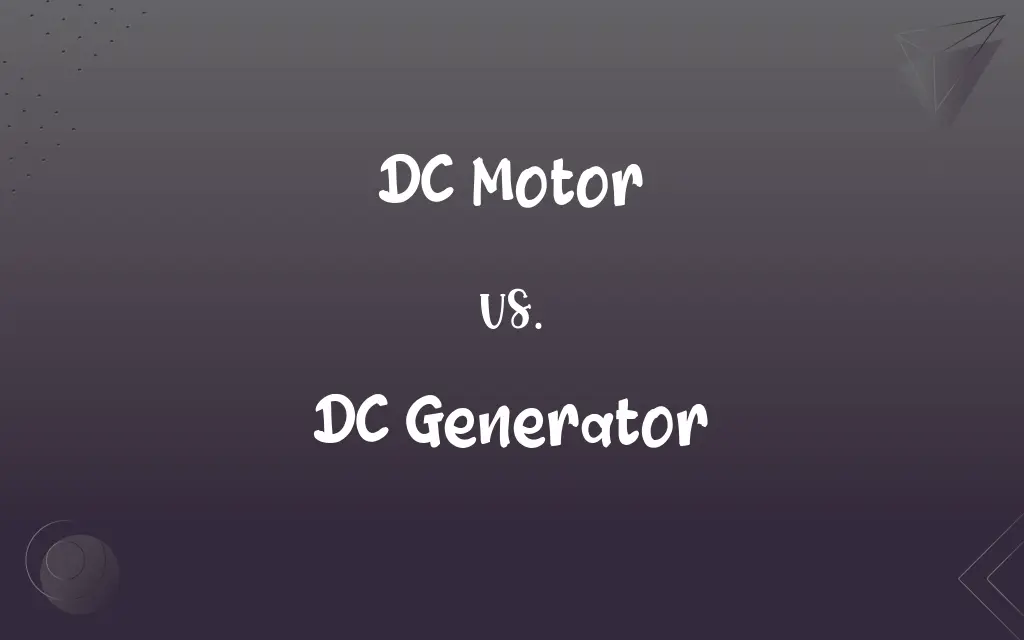DC Motor vs. DC Generator: What's the Difference?
Edited by Aimie Carlson || By Harlon Moss || Updated on October 3, 2023
A DC motor converts electrical energy to mechanical motion, while a DC generator converts mechanical motion to electrical energy.

Key Differences
A DC motor is essentially a device that converts direct current electrical power into mechanical power. On the other hand, a DC generator performs the inverse function, transforming mechanical power into direct current electrical power.
The working principle of a DC motor is based on the Lorentz force equation, which states that a current-carrying conductor experiences a force when placed in a magnetic field. Conversely, a DC generator operates based on Faraday’s law of electromagnetic induction which explains the generation of EMF due to the change of magnetic flux.
The main components of a DC motor include a rotor (or armature), brushes, a commutator, and field windings, whereas a DC generator typically consists of a commutator, brushes, an armature, and field windings, having similarities in components but differing in their structural utilization.
In practical applications, a DC motor is primarily used to provide continuous rotational movement and torque, making it suitable for machines, appliances, and electronic devices. Whereas a DC generator finds its application where power generation is needed, such as in remote locations, emergency power backup, or small-scale energy production.
An interesting note is the reversibility of function in many instances between a DC motor and a DC generator. Sometimes a DC motor can act as a generator (and vice versa) under certain conditions, reflecting the close relationship and similar structural elements of the two.
ADVERTISEMENT
Comparison Chart
Function
Converts electrical energy to mechanical energy
Converts mechanical energy to electrical energy
Principle
Based on Lorentz force
Based on Faraday's law
Usage
Provides continuous rotational movement and torque
Used for power generation
Current Flow
From electrical circuit to motor
From generator to electrical circuit
Energy Input
Electrical energy
Mechanical energy
ADVERTISEMENT
DC Motor and DC Generator Definitions
DC Motor
A DC motor is a device converting electrical energy into mechanical motion.
The toy car moves smoothly powered by a small DC motor.
DC Generator
A DC generator converts mechanical energy into direct current electrical energy.
During power outages, the DC generator provides emergency power to essential appliances.
DC Motor
DC motors can operate on batteries or any DC power supply.
The flashlight operates by using a DC motor powered by batteries.
DC Generator
In DC generators, mechanical motion is required to create electrical energy.
The windmill employs a DC generator to convert wind energy into electrical power.
DC Motor
DC motors utilize direct current to generate rotational motion.
Fans commonly use DC motors to achieve steady rotational motion.
DC Generator
DC generators produce electricity utilizing electromagnetic induction.
The hand-crank flashlight uses a small DC generator to produce light.
DC Motor
DC motors are characterized by continuous and steady rotational motion.
The conveyor belt utilizes a DC motor to maintain a consistent movement of goods.
DC Generator
DC generators typically involve a commutator to produce direct current.
In many older lighthouses, a DC generator was used to supply the necessary electrical power.
DC Motor
In DC motors, the speed and direction can be easily controlled.
The robotic arm uses a DC motor for precise and controlled movements.
DC Generator
DC generators are utilized in power production in remote or off-grid locations.
Campers often use a DC generator to power electronic devices in isolated spots.
FAQs
What is armature reaction in a DC generator?
Armature reaction in a DC generator refers to the effect of the magnetic field produced by the armature current on the distribution of the flux under the main poles.
What role does a commutator play in a DC generator?
In a DC generator, the commutator helps to convert the alternating current generated in the coil into direct current before it is drawn off to the external circuit.
In what applications is a DC motor typically found?
DC motors are typically found in applications like electric vehicles, household appliances, and industrial machinery, where precise speed control is required.
How does a DC motor produce torque?
A DC motor produces torque through the interaction of magnetic fields created by current flowing through both the armature and field windings.
What factors influence the output voltage of a DC generator?
Factors like speed of rotation, number of coils, coil area, and magnetic field strength influence the output voltage of a DC generator.
How does armature resistance affect a DC motor's performance?
Armature resistance in a DC motor affects its performance by influencing the voltage drop across the armature, which in turn affects torque and speed.
What is the function of brushes in a DC motor?
Brushes in a DC motor maintain electrical contact with the commutator, ensuring the current direction remains constant, enabling steady motor rotation.
How can the speed of a DC motor be controlled?
The speed of a DC motor can be controlled by varying the supply voltage or changing the field winding currents.
Can a DC generator produce alternating current?
No, a DC generator is designed to produce direct current, utilizing a commutator to keep the current flow direction constant.
What are common problems encountered with DC motors?
Common problems with DC motors include worn brushes, bearing failures, and issues related to overheating, all of which can impact performance.
How is the efficiency of a DC motor determined?
The efficiency of a DC motor is determined by comparing its mechanical output power with the electrical input power, and it’s usually expressed as a percentage.
How are DC generators classified?
DC generators are primarily classified based on how their field winding is powered – series, shunt, and compound generators.
What is critical resistance in a DC generator?
Critical resistance in a DC generator refers to the resistance at which the generated voltage will be maximum for a given speed.
What is the purpose of field windings in a DC generator?
Field windings in a DC generator create a magnetic field which interacts with the armature to generate electrical energy.
Can a DC generator charge a battery?
Yes, a DC generator can charge a battery, providing the output voltage of the generator is higher than the battery voltage.
How is a DC generator used?
A DC generator is used to convert mechanical energy into direct current electrical energy.
How does back EMF affect a DC motor's operation?
Back EMF in a DC motor opposes the applied voltage, indirectly controlling the armature current and thus regulating the motor's speed.
Can a DC motor run on AC power?
While primarily designed for DC, some DC motors can run on AC power, but it may not be optimal and could affect the motor’s longevity and performance.
What is a DC motor?
A DC motor converts direct current electrical energy into mechanical energy.
Can a DC motor work as a generator?
Yes, when mechanically driven, a DC motor can work as a generator, converting mechanical energy into electrical energy.
About Author
Written by
Harlon MossHarlon is a seasoned quality moderator and accomplished content writer for Difference Wiki. An alumnus of the prestigious University of California, he earned his degree in Computer Science. Leveraging his academic background, Harlon brings a meticulous and informed perspective to his work, ensuring content accuracy and excellence.
Edited by
Aimie CarlsonAimie Carlson, holding a master's degree in English literature, is a fervent English language enthusiast. She lends her writing talents to Difference Wiki, a prominent website that specializes in comparisons, offering readers insightful analyses that both captivate and inform.































































